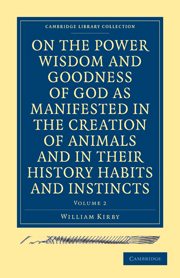Book contents
- Frontmatter
- Contents
- EXPLANATION OF PLATES
- CHAP. XIII Functions and Instincts. Cirripedes and Crinoïdeans
- CHAP. XIV Functions and Instincts. Entomostracan Condylopes
- CHAP. XV Functions and Instincts. Crustacean Condylopes
- CHAP. XVI Functions and Instincts. Myriapod Condylopes
- CHAP. XVII Motive, locomotive and prehensory organs
- CHAP. XVIII Instinct in general
- CHAP. XIX Functions and Instincts. Arachnidans, Pseudarachnidans, and Acaridan Condylopes
- CHAP. XX Functions and Instincts. Insect Condylopes
- CHAP. XXI Functions and Instincts. Fishes
- CHAP. XXII Functions and Instincts. Reptiles
- CHAP. XXIII Functions and Instincts. Birds
- CHAP. XXIV Functions and Instincts. Mammalians
- CHAP. XXV Functions and Instincts. Man
- CONCLUSION
- Index
- Plate section
CHAP. XXIII - Functions and Instincts. Birds
Published online by Cambridge University Press: 29 August 2010
- Frontmatter
- Contents
- EXPLANATION OF PLATES
- CHAP. XIII Functions and Instincts. Cirripedes and Crinoïdeans
- CHAP. XIV Functions and Instincts. Entomostracan Condylopes
- CHAP. XV Functions and Instincts. Crustacean Condylopes
- CHAP. XVI Functions and Instincts. Myriapod Condylopes
- CHAP. XVII Motive, locomotive and prehensory organs
- CHAP. XVIII Instinct in general
- CHAP. XIX Functions and Instincts. Arachnidans, Pseudarachnidans, and Acaridan Condylopes
- CHAP. XX Functions and Instincts. Insect Condylopes
- CHAP. XXI Functions and Instincts. Fishes
- CHAP. XXII Functions and Instincts. Reptiles
- CHAP. XXIII Functions and Instincts. Birds
- CHAP. XXIV Functions and Instincts. Mammalians
- CHAP. XXV Functions and Instincts. Man
- CONCLUSION
- Index
- Plate section
Summary
We are now arrived at the highest department of the animal kingdom, the members of which are not only distinguished by a vertebral column, but also by warm red blood, and a more ample brain. This department consists of two great Classes, viz. those that are oviparous, and do not suckle their young; and those that are viviparous, which suckle their young till they are able to provide for themselves. The first of these Classes consists of the Birds, and the last of the Quadrupeds, Whales, and Seals, called from the above circumstance Mammalians. Man, though physically belonging to the latter Class, metaphysically considered, is placed far above the whole animal kingdom, by being made in the image and after the likeness of his Creator, receiving from him immediately a reasonable and immortal soul; and entrusted by him with dominion over the fish of the sea, and over the fowl of the air, and over every living thing that moveth upon the earth.
Having, in a former chapter, given some account of those animals, to which the waters of this globe are assigned as their habitation and scene of action, I am now to consider those which their Creator has endowed with a power denied to man, and most of the Mammalians—that of moving to and fro in the air as the fishes do in the water, which, on that account, though they move also on the earth, are denominated, in the passage just quoted, the fowl of the air.
- Type
- Chapter
- Information
- On the Power, Wisdom and Goodness of God as Manifested in the Creation of Animals and in their History, Habits and Instincts , pp. 435 - 474Publisher: Cambridge University PressPrint publication year: 2009First published in: 1835

